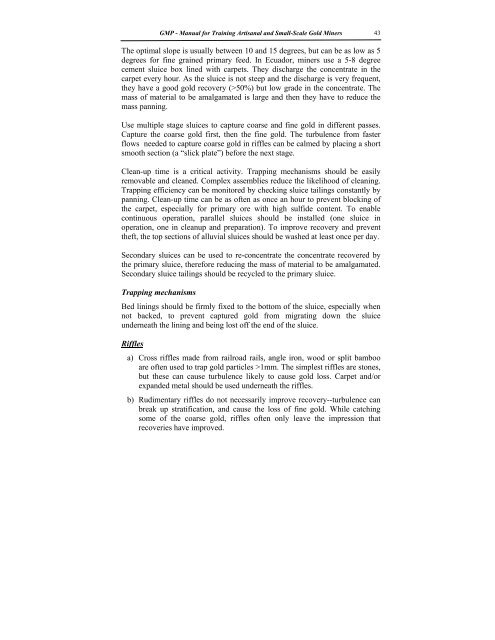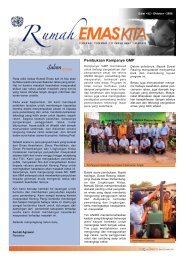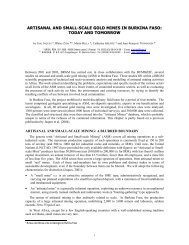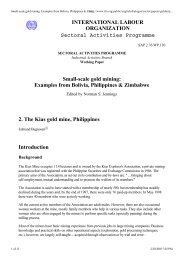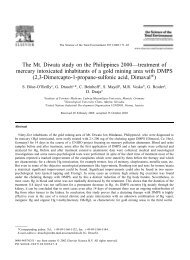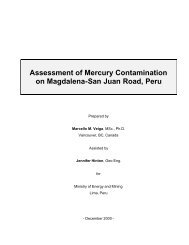Manual for Training Artisanal and Small-Scale Gold Miners
Manual for Training Artisanal and Small-Scale Gold Miners
Manual for Training Artisanal and Small-Scale Gold Miners
Create successful ePaper yourself
Turn your PDF publications into a flip-book with our unique Google optimized e-Paper software.
GMP - <strong>Manual</strong> <strong>for</strong> <strong>Training</strong> <strong>Artisanal</strong> <strong>and</strong> <strong>Small</strong>-<strong>Scale</strong> <strong>Gold</strong> <strong>Miners</strong><br />
The optimal slope is usually between 10 <strong>and</strong> 15 degrees, but can be as low as 5<br />
degrees <strong>for</strong> fine grained primary feed. In Ecuador, miners use a 5-8 degree<br />
cement sluice box lined with carpets. They discharge the concentrate in the<br />
carpet every hour. As the sluice is not steep <strong>and</strong> the discharge is very frequent,<br />
they have a good gold recovery (>50%) but low grade in the concentrate. The<br />
mass of material to be amalgamated is large <strong>and</strong> then they have to reduce the<br />
mass panning.<br />
Use multiple stage sluices to capture coarse <strong>and</strong> fine gold in different passes.<br />
Capture the coarse gold first, then the fine gold. The turbulence from faster<br />
flows needed to capture coarse gold in riffles can be calmed by placing a short<br />
smooth section (a “slick plate”) be<strong>for</strong>e the next stage.<br />
Clean-up time is a critical activity. Trapping mechanisms should be easily<br />
removable <strong>and</strong> cleaned. Complex assemblies reduce the likelihood of cleaning.<br />
Trapping efficiency can be monitored by checking sluice tailings constantly by<br />
panning. Clean-up time can be as often as once an hour to prevent blocking of<br />
the carpet, especially <strong>for</strong> primary ore with high sulfide content. To enable<br />
continuous operation, parallel sluices should be installed (one sluice in<br />
operation, one in cleanup <strong>and</strong> preparation). To improve recovery <strong>and</strong> prevent<br />
theft, the top sections of alluvial sluices should be washed at least once per day.<br />
Secondary sluices can be used to re-concentrate the concentrate recovered by<br />
the primary sluice, there<strong>for</strong>e reducing the mass of material to be amalgamated.<br />
Secondary sluice tailings should be recycled to the primary sluice.<br />
Trapping mechanisms<br />
Bed linings should be firmly fixed to the bottom of the sluice, especially when<br />
not backed, to prevent captured gold from migrating down the sluice<br />
underneath the lining <strong>and</strong> being lost off the end of the sluice.<br />
Riffles<br />
a) Cross riffles made from railroad rails, angle iron, wood or split bamboo<br />
are often used to trap gold particles >1mm. The simplest riffles are stones,<br />
but these can cause turbulence likely to cause gold loss. Carpet <strong>and</strong>/or<br />
exp<strong>and</strong>ed metal should be used underneath the riffles.<br />
b) Rudimentary riffles do not necessarily improve recovery--turbulence can<br />
break up stratification, <strong>and</strong> cause the loss of fine gold. While catching<br />
some of the coarse gold, riffles often only leave the impression that<br />
recoveries have improved.<br />
43


